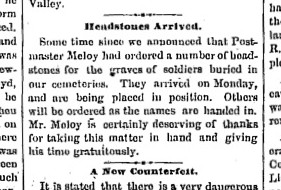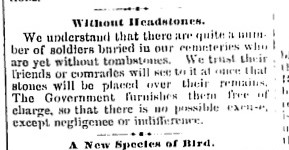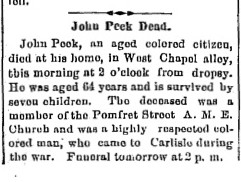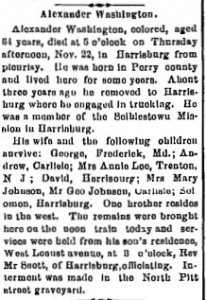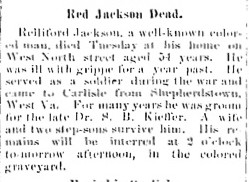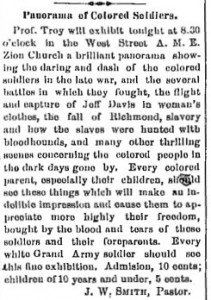To try to research efficiently with microfilm, I assembled the list of soldiers at Lincoln Cemetery of whom I knew their death dates. I figured that when people die, especially veterans, newspapers will often post a brief biography about their life or at least some aspect of their story. I assembled this list below of death dates from Cavenagh’s headstone writings.
- James O Williams – October 31st, 1865
- Sgt. Robert A Rondel – February 24th, 1890
- Nathaniel J. Stubbs – December 18th, 1892
- John G. Peck – September 25, 1895
- George W. Jackson – July 24th, 1896
- Henry W. Spradley – April 9th, 1897
- James Welcome – April 17th, 1898
- Alexander Washington – November 22nd, 1900
I then started going through the microfilm of the Carlisle Herald, on microfilm at Widner-Spahr library. Basically, I decided I would look from one day before the death to three weeks after the death for any mention of the names. I know this is not an exhaustive study, but this was the most efficient way for time constraints.
First off, I did not have time to look into James Williams. Looking through microfilm for Rondel, Welcome, and Stubbs, I could not find anything for this newspaper. Obviously there might be more on them in another newspaper. However, when searching through 1882-1885 on Reel 42, I found two newspaper entries that mentioned William Cephas, Dennie Bush, R. B. Howard, and Geo. Fisher. It encouraged people to make sure Veterans gravestones were ordered and that no soldier was overlooked.
Below this, I have two more brief articles I found about the headstones. What I eventually realized was that the town was trying to get all of these headstones in place before May 30th, which was decoration day for the grave sties.
When I looked at microfilm reels for John Peck, I found one article as well. It explains that the A.M.E. church would burry him at 2pm the next day, which was the normal church and time from what I researched. I heard that John Peck was a prominent abolitionist, and this is something I would like to look into at CCHS more. This article gave me more confidence in that since they mentioned he was prominent in the community.
I was able to find an article about Alexander Washington as well. It tells a little about the different places where he lived, how old he was and when he died. It also makes it clear that he was buried in the cemetery off of North Pitt street, confirming that he was in Lincoln Cemetery.
In addition to these articles, I stumbled upon a few other African Americans buried around this time period, such as Emma Jackson and Relliford Jackson. The later is very interesting because it says that Jackson was an African American who fought in the Civil War and then moved to Carlisle. When he died, they wrote that he was buried in the “colored graveyard.” Which at this point, should be Lincoln and not Union Cemetery. So it’s very possible with some further research that I could prove another black veteran is buried there.
I also found one more article that could be a big lead for future research. It explains that “Prof. Troy” one night hosted a night of images of local black soldier pictures at A.M.E. I may have interpreted panorama wrong, but I really hoped to look into this article further.
Finally, I found multiple articles on Henry Spradley, who I will elaborate on later in a separate post. I really think that microfilm is the way to go for this research. If I had time to go through all the Carlisle newspapers and read them column after column, it would be possible to really piece together some of this history.


